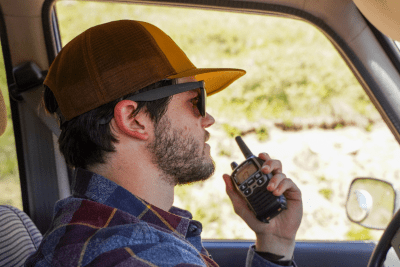Understanding Range- How Two-Way Radios Work

Table of Contents
Understanding two-way radio range might seem intimidating or confusing, but it doesn't have to be.
Two-way radio range isn't exact and it isn't the same every time you use the same radio. It's typically impacted by several factors, including radio capability and configuration, and environmental impact.
TWO-WAY RADIO CAPABILITY AND CONFIGURATION
Radio capability and configuration determines what the two-way radio can do and how you can use it.
TRANSMITTER
Two-way radios convert audio to radio waves that are transmitted through the air. Other radios receive these waves, converting them into audio.
Transmitter power is a key capability and is measured by its wattage. The FCC (Federal Communications Commission) has regulatory limits on the wattage of two-way radios.
Family Radio Service (FRS) has a maximum of two watts of power. General Mobile Radio Service (GMRS) two-way radios can use up to 50 watts of power.
Power in handhelds is limited by other factors such as battery life and RF exposure restrictions.
The FCC also limits the transmitting power to half a watt on certain channels. For Midland's two-way radios, those are channels 8-14 and 34-37.
Keep in mind for handhelds, it uses more battery to transmit at a higher power. Users need a two-way radio with good battery capacity to communicate longer on high power settings. The user will also want to make sure the battery is charged.
RECIEVER
The quality of a two-way radio's reception will also directly impact range.
Users should be aware that a higher powered radio transmission might be received by a lower powered radio, but a lower powered radio transmission might not be received by a higher powered radio that is too far away.
However, if a two-way radio has a monitor feature like Midland's do, users can use that to hear a weaker signal and potentially increase range.
REPEATERS
Repeaters can be used to improve two-way radio range. A repeater relays signals between two-way radios.
As long as repeater capable two-way radios are in reach of the repeater, they can communicate with one another even though they might not be in range of each other.
ENVIRONMENTAL
The environment in which users are putting two-way radios to the test also impacts range.
LINE OF SIGHT
Two-way radio range is determined by clear line of sight. The more direct your line of sight, the better your range will be.
The curvature of the earth also impacts radio range because it can affect line of sight. That's why transmitting between a mountain or hill and a valley typically results in better range.
OBSTRUCTIONS
Interruptions to line of sight like obstructions can get in the way of two-way radio waves and hurt range.
Some examples of obstructions include:
- Vehicles
- Trees
- Mountains
- Buildings
- Hills
This is why it's helpful to put an antenna outside the vehicle, as the vehicle acts as an obstruction and will potentially impede communication.
WEATHER
Depending on conditions, weather may better or worsen two-way radio range.
For example, range can vary between two locations when it's cloudy versus clear.
ANTENNA QUALITY
For radios without a fixed antenna, choosing the right antenna is pertinent to two-way radio range.
When making the selection, communicators should take into account the dB gain of the antenna and the environment in which they're using their radios.
The antenna must be designed well to transmit well in every direction from the antenna.
Not only do users want to ensure they're making the right decision, but quality is everything. Choose an antenna that you trust to bring reliability to communication.





